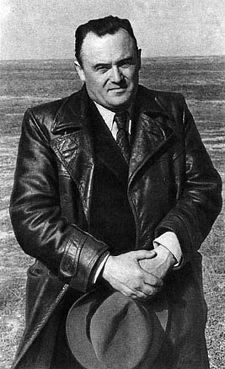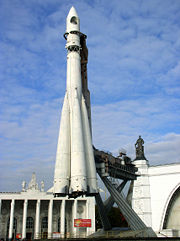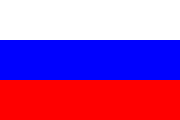Soviet space program

The Soviet space program consisted of initiatives within the Soviet Union by competing design groups. Being primarily a military program, it was classified. Sergey Korolyov[1] (also transliterated as Korolev) was the head of the principal design group; his official title was "chief designer" (a standard title for similar positions in USSR). Unlike the US space program, which was mostly open and in public view, announcements of the outcomes of missions were delayed until success was certain and failures were sometimes kept secret. Ultimately, as a result Gorbachev's policy of glasnost, many facts about the space program (which was heavily connected to the military) were declassified.
The Soviet Space Program was dissolved with the fall of the Soviet Union, with Russia and Ukraine becoming its immediate heirs. Russia continued its program by creating the Russian Aviation and Space Agency, now known as the Russian Federal Space Agency (RKA)[2], while Ukraine created the National Space Agency of Ukraine (NSAU).
Contents |
Origins
The theory of space exploration was well established in the Russian Empire before the First World War from the writings of Konstantin Tsiolkovsky, who published pioneering papers in the late 19th and early 20th centuries and in 1929 even introduced the concept of the multistaged rocket. Similarly the practical aspects were established by early experiments carried out by the reactive propulsion study group, GIRD in the 1920s and 1930s, where such pioneers as German engineer Friedrich Zander and Sergey Korolyov worked.
On August 18, 1933 GIRD, launched the first Soviet liquid-fueled rocket Gird-09, and on November 25, 1933 the first hybrid-fueled rocket GIRD-X. In 1940-41 another advance in the reactive propulsion field was made: the development and serial production of the Katyusha[3] multiple rocket launcher, which was feared by the Nazis. Further advances were made through reverse engineering of artifacts seized at the end of the Second World War, in particular drawings obtained from the V-2 production sites (after the Americans secretly moved most German scientists to the US - see Operation Paperclip along with several V-2 rockets).
Under the direction of Dimitri Ustinov, designer and engineer Sergey Korolyov inspected the drawings. Helped by German scientists, especially rocket scientist Helmut Gröttrup, they built a replica of the V-2 called the R-1, although the weight of Soviet nuclear warheads required a more powerful booster. Korolyov was dedicated to the liquid-fuelled cryogenic rockets he had been experimenting with in the late 1930s. Ultimately, this work resulted in the design of the R-7 Semyorka[4] intercontinental ballistic missile (ICBM) which was successfully tested in August 1957. Because of its global range and large payload (approximately 5 tons), the reliable R7 was not only effective as a strategic delivery system for nuclear warheads, but also as an excellent basis for a space vehicle.

The Soviet space program was tied to the USSR's Five-Year Plans and from the start was reliant on support from the Soviet military. In January 1956, plans were approved for Earth-orbiting satellites to gain knowledge of space, (Sputnik), and four unmanned military reconnaissance satellites, (Zenit). Further planned developments called for a manned Earth orbit flight by 1964 and an unmanned lunar mission at an earlier date. After the first Sputnik proved to be a successful propaganda coup, Korolyov was charged to accelerate the manned program, the design of which was combined with the Zenit program to produce the Vostok spacecraft.
Following the death of Korolyov in 1966, Kerim Kerimov, who was formerly an architect of Vostok 1,[5] was appointed Chairman of the State Commission on Piloted Flights and headed it for the next 25 years (1966–1991). He supervised every stage of development and operation of both manned space complexes as well as unmanned interplanetary stations for the former Soviet Union. One of Kerimov's greatest achievements was the launch of Mir in 1986.
Firsts
Two days after the United States announced its intention to launch an artificial satellite, on July 31, 1956, the Soviet Union announced its intention to do the same. Sputnik 1 was launched on October 4, 1957, beating the United States and stunning people all over the world.

The Soviet space program pioneered many aspects of space exploration:
- 1957: First intercontinental ballistic missile, the R-7 Semyorka
- 1957: First satellite, Sputnik 1
- 1957: First animal to enter Earth orbit, the dog Laika on Sputnik 2
- 1959: First firing of a rocket in Earth orbit, first man-made object to escape Earth's orbit, Luna 1
- 1959: First data communications, or telemetry, to and from outer space, Luna 1.
- 1959: First man-made object to pass near the Moon, first man-made object in Solar orbit, Luna 1
- 1959: First probe to impact the moon, Luna 2
- 1959: First images of the moon's far side, Luna 3
- 1960: First animals to safely return from Earth orbit, the dogs Belka and Strelka on Sputnik 5.
- 1960: First probe launched to Mars, Marsnik 1
- 1961: First probe launched to Venus, Venera 1
- 1961: First person in space (International definition) and in Earth orbit, Yuri Gagarin on Vostok 1, Vostok programme
- 1961: First person to spend over a day in space Gherman Titov, Vostok 2 (also first person to sleep in space).
- 1962: First dual manned spaceflight and approach, Vostok 3 and Vostok 4
- 1963: First woman in space, Valentina Tereshkova, Vostok 6
- 1964: First multi-man crew (3), Voskhod 1
- 1965: First EVA, by Aleksei Leonov, Voskhod 2
- 1965: First probe to hit another planet (Venus), Venera 3
- 1966: First probe to make a soft landing on and transmit from the surface of the moon, Luna 9
- 1966: First probe in lunar orbit, Luna 10
- 1967: First unmanned rendezvous and docking, Cosmos 186/Cosmos 188. (Until 2006, this had remained the only major space achievement that the US had not duplicated.)
- 1969: First docking between two manned craft in Earth orbit and exchange of crews, Soyuz 4 and Soyuz 5
- 1970: First samples automatically returned to Earth from another body, Luna 16
- 1970: First robotic space rover, Lunokhod 1
- 1970: First data received from the surface of another planet (Venus), Venera 7
- 1971: First space station, Salyut 1
- 1971: First probe to orbit another planet (Mars), first probe to reach surface of Mars, Mars 2
- 1975: First probe to orbit Venus, first photos from surface of Venus, Venera 9
- 1984: First woman to walk in space, Svetlana Savitskaya (Salyut 7 space station)
- 1986: First crew to visit two separate space stations (Mir and Salyut 7)
- 1986: First permanently manned space station, Mir, which orbited the Earth from 1986 until 2001
- 1987: First crew to spend over one year in space, Vladimir Titov and Musa Manarov on board of TM-4 - Mir

- In addition, except for the period following Korolyov's death in 1965 through the end of the Skylab program in 1974, virtually all manned duration records have been set by Russians, largely because of the Salyut/Mir series of space stations.
Internal competition

Unlike the American Space program which had NASA as a single coordinating structure directed by its Administrator, James Webb through most of the 1960s, the USSR's program was split between several competing design groups led by Sergey Korolyov, Mikhail Yangel, Valentin Glushko and Vladimir Chelomei.
Following the remarkable successes of the Sputniks between 1957 and 1961 and Vostoks between 1961 and 1964, Korolyov's OKB-1 design bureau was gaining influence and planned to move forward with the Soyuz craft and N-1 heavy booster that would be the basis of a permanent manned space station and manned exploration of the moon. However, Ustinov directed him to focus on near-Earth missions using the very reliable Voskhod spacecraft, a modified Vostok, as well as on interplanetary unmanned missions to nearby planets Venus and Mars.
Yangel had been Korolyov's assistant but with the support of the military was given his own design bureau in 1954 to work primarily on the military space program. This had the stronger rocket engine design team including the use of hypergolic fuels but following the Nedelin catastrophe in 1960 Yangel was directed to concentrate on ICBM development. He also continued to develop his own heavy booster designs similar to Korolyov's N-1 both for military applications and for cargo flights into space to build future space stations.
Glushko was the chief rocket engine designer but had a personal friction with Korolyov and refused to develop the large single chamber cryogenic engines that Korolyov needed to build heavy boosters.
Chelomei benefited from the patronage of Khrushchev and in 1960 was given the plum jobs of developing a rocket to send a manned craft around the moon and a manned military space station - but with limited experience his development was slow.
At one stage in the early 1960s the Soviet space program was actively developing 30 projects for launchers and spacecraft. With the fall of Krushchev in 1964 Korolyov was given complete control of the manned space program.
After Korolyov

Korolyov died following a routine operation that uncovered colon cancer and from complications from heart disease and severe hemorraging in January 1966. Leadership of the OKB-1 design bureau was given to Vasili Mishin, who had the task of sending a man around the moon in 1967 and landing a man on it in 1968.
Mishin lacked Korolyov's political authority and still faced competition from other chief designers. Under pressure Mishin approved the launch of the Soyuz 1 flight in 1967, even though the craft had never been successfully tested on an unmanned flight. The mission launched with known design problems and ended with the vehicle crashing to the ground, killing Vladimir Komarov. This was the first in-flight fatality.
Following this disaster and under new pressures, Mishin developed a drinking problem. The Soviets were narrowly beaten in sending the first manned flight around the moon in 1968 by Apollo 8, but Mishin pressed ahead with development of the problematic N1 rocket in the hope that the Americans would have a setback, leaving enough time to make the N-1 workable and land a man on the moon first. There was a success with the joint flight of Soyuz 4 and Soyuz 5 in January 1969 that tested the rendezvous, docking and crew transfer techniques that would be used for the landing, and the LK Lander was tested successfully in earth orbit. But after four unmanned test launches of the N-1 ended in failure, the heavy booster was abandoned and with it any chance of the Soviets landing men on the moon in a single launch.
Following this setback, Chelomei convinced Ustinov to approve a program in 1970 to advance his Almaz military space station as a means of beating the US's announced Skylab. Mishin remained in control of the project that became Salyut but the decision backed by Mishin to fly a three-man crew without pressure suits rather than a two-man crew with suits to Salyut 1 in 1971 proved fatal when the re-entry capsule depressurized killing the crew on their return to Earth. Mishin was removed from many projects, with Chelomei regaining control of Salyut. After working with NASA on the Apollo Soyuz Test Project, the Soviet leadership decided a new management approach was needed and in 1974 the N-1 was cancelled and Mishin dismissed. A single design bureau was created NPO Energia with Glushko as chief designer.
Failures
The Soviet program suffered various incidents and setbacks.
The Soviet space program was tied to the central planning of the USSR's five-year plans. This made it difficult for the Chief Designers to respond in 1961 to the US launching a crash program for a manned lunar landing as the next five-year plan would not start until 1964. Centralised planning and the concentration on production targets also made it difficult for middle management and engineers to highlight defects in equipment leading to poor quality control.
The Soviet space program produced the first cosmonaut fatality on March 23, 1961 when Valentin Bondarenko died in a fire within a low pressure, high oxygen atmosphere.
The Voskhod program was cancelled after two manned flights owing to the change of Soviet leadership and the near fatality of the second mission. Had the planned further flights gone ahead they could have given the Soviet space program further 'firsts' including a long duration flight of 20 days, a spacewalk by a woman and an untethered spacewalk.
The deaths of Korolyov, Komarov (in the Soyuz 1 crash) and Gagarin (on routine fighter jet mission) within two years of each other understandably had some negative impact on the Soviet program.
The Soviets continued striving for the first lunar mission with the huge N-1 rocket which exploded on each of four unmanned tests. The first exploded in midair. The second had a very complicated loss: as the rocket launched, all of its engines shut down because of a single small bolt that had been sucked into a fuel pump. A few engines continued to fire, but they were not enough, and the crash was the worst in the history of the Soviet space program. The last two suffered similar losses to the first one. The Americans won the race to land men on the moon with Apollo 11 in July 20, 1969.
On April 5, 1975, the second stage of a Soyuz rocket carrying 2 cosmonauts to the Salyut 4 space station malfunctioned, resulting in the first manned launch abort. The cosmonauts were carried several thousand miles downrange and became worried that they would land in China, which the Soviet Union was then having difficult relations with. The capsule hit a mountain, sliding down a slope and almost slid off a cliff; fortunately the parachute lines snagged on trees and kept this from happening. As it was, the two suffered severe injuries and the commander, Lazerev, never flew again.
On March 18, 1980 a Vostok rocket exploded on its launch pad during a fueling operation killing 48 people.
In the summer of 1981 Kosmos-434, which had been launched in 1971, was about to re-enter. To allay fears that the spacecraft carried nuclear materials, a spokesperson from the USSR Ministry of Foreign Affairs assured the Australian government on August 26, 1981 that the satellite was "an experimental lunar cabin". This was one of the first admissions by the Soviet Union that it had ever engaged in a manned lunar spaceflight program.[6]
In September 1983, a Soyuz rocket being launched to carry cosmonauts to the Salyut 7 space station exploded on the pad, causing the Soyuz capsule's abort system to engage, saving the two cosmonauts on board.
The Soviet space program produced the Space Shuttle Buran based on the Energia launcher. Energia would be used as the base for a manned Mars mission. Buran was intended to operate in support of large space based military platforms as a response first to the US Space Shuttle and then the Strategic Defense Initiative. By the time the system was operational, in 1988, strategic arms reduction treaties and the end of the Cold War made Buran redundant. Several vehicles were built, but only one flew an unmanned test flight; it was found too expensive to operate as a civilian launcher.
See also the complete list of space disasters.
Projects
Completed
The Soviet space program has undertaken a number of projects, including:
- Almaz space stations
- Buran shuttle
- Cosmos satellites
- Energia
- Foton
- N1-L3 Manned Moon landing program
- Luna Moon probe program
- Mars probe program
- Meteor meteorological satellites
- Molniya communications satellites
- Mir space station
- Proton satellite satellites
- Phobos Mars probes program
- Salyut space stations
- Soyuz programme
- Sputnik program satellites
- TKS spacecraft spacecraft
- Venera Venus probes program
- Vega program Venus and comet Halley probes program
- Vostok programme spacecraft
- Voskhod programme spacecraft
- Zond program

Other planned projects were not developed due to the fall of the Soviet Union. These included:
Vesta mission
The Vesta mission would have consisted of two identical probes to be launched in 1991. It was intended to fly-by Mars and then study four small bodies, including asteroids belonging to different classes. At 4 Vesta a penetrator would be released.
References
- ↑ http://www.iafastro.com/index.php?id=524
- ↑ http://www.roscosmos.ru/index.asp?Lang=ENG
- ↑ http://www.globalsecurity.org/military/world/russia/katyusha.htm
- ↑ http://history.nasa.gov/SP-4110/vol2.pdf
- ↑ Peter Bond, Obituary: Lt-Gen Kerim Kerimov, The Independent, 7 April 2003.
- ↑ Siddiqi. Challenge To Apollo The Soviet Union and The Space Race, 1945-1974. NASA. pp. p. 736. http://ntrs.nasa.gov/search.jsp?Ntk=all&Ntx=mode%20matchall&Ntt=SP-2000-4408.
See also
- Sergey Korolyov
- Cosmonaut
- Yuri Gagarin
- MIR
- Voskhod program
- Laika
- Russian space dogs
- Konstantin Tsiolkovsky
- N1-L3 Manned Moon Landing
Chronologies
External links
- Russian Space Web
- Soviet Space Web
- Soviet Exploration of Venus
- Sputnik: 50 Years Ago
- PBS Red Files
- Korolev, Mastermind of the Soviet Space Program
- Cosmos Family
- Soviet manned lunar program
- Russian Space Program
- The Cosmonautics Memorial Museum in Moscow
|
||||||||||||||||
|
|||||||||||||||||||
|
|||||||||||
|
|||||||||||||||||



